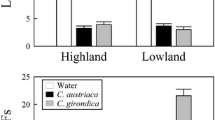Abstract
The ability to recognize conspecifics is indispensible for differential treatment of particular individuals in social contexts like grouping behavior. The advantages of grouping are multifarious, and there exist numerous additional benefits of joining aggregations of conspecifics. Recognition is based on different signals and transmitted via multiple channels, among others the olfactory channel. The sensory system or the combination of sensory modalities used in recognition processes is highly dependent on the availability and effectiveness of modalities, which are a function of the environmental conditions. Using F1-generations of six three-spined stickleback (Gasterosteus aculeatus) populations from two habitat types (tea-stained and clear-water lakes) from the Outer Hebrides, Scotland, we investigated whether individuals are able to recognize members of their own population solely based on olfactory cues and whether the habitat type an individual originated from had an influence on its recognition abilities. When given the choice (own vs. foreign population) sticklebacks from tea-stained lakes significantly preferred the odor of their own population, whereas fish from clear-water habitats did not show any preference. Moreover, fish from the two habitat types differed significantly in their recognition abilities, indicating that olfactory communication is better developed when visual signaling is disturbed. Thus, the observed odor preferences appear to be the consequence of different selective constraints and adaptations as a result of the differences in environmental conditions that have acted on the parental generations. These adaptations are likely genetically based as the differences are present in the F1-generation that had been reared under identical laboratory conditions.




Similar content being viewed by others
References
Bakker TCM, Milinski M (1993) The advantages of being red: sexual selection in the stickleback. Mar Behav Physiol 23:287–300
Behrmann-Godel J, Gerlach G, Eckmann R (2006) Kin and population recognition in sympatric Lake Constance perch (Perca fluviatilis L.): can assortative shoaling drive population divergence? Behav Ecol Sociobiol 59:461–468
Bell MA, Foster SA (1994) The evolutionary biology of the threespine stickleback. Oxford University Press, Oxford
Bolger T, Connolly PL (1989) The selection of suitable indices for the measurement and analysis of fish condition. J Fish Biol 34:171–182
Borg B, Bornestaf C, Hellqvist A, Schmitz M, Mayer I (2004) Mechanisms in the photoperiodic control of reproduction in the stickleback. Behaviour 141:1521–1530
Candolin U (2003) The use of multiple cues in mate choice. Biol Rev 78:575–595
Chapman BB, Morrell LJ, Tosh CR, Krause J (2010) Behavioural consequences of sensory plasticity in guppies. Proc R Soc B 277:1395–1401
Chivers DP, Brown GE, Smith RJF (1995) Familiarity and shoal cohesion in fathead minnows (Pimephelas promelas): implications for antipredator behavior. Can J Zool 73:955–960
Courtenay SC, Quinn TP, Dupuis HMC, Groot C, Larkin PA (1997) Factors affecting the recognition of population-specific odours by juvenile coho salmon. J Fish Biol 50:1042–1060
Dawley EM (1984) Recognition of individual, sex and species odors by salamanders of the Plethodon glutinosus-Plethodon jordani complex. Anim Behav 32:353–361
Douglas RH, Hawryshyn CW (1990) Behavioural studies of fish vision: an analysis of their capabilities. In: Douglas RH, Djamgoz MBA (eds) The visual system of fish. Chapman and Hall, London, pp 373–418
Fisher HS, Wong BBM, Rosenthal GG (2006) Alteration of the chemical environment disrupts communication in a freshwater fish. Proc R Soc B 273:1187–1193
Gerlach G, Hodgins-Davis A, MacDonald B, Hannah RC (2007) Benefits of kin association: related and familiar zebrafish larvae (Danio rerio) show improved growth. Behav Ecol Sociobiol 61:1765–1770
Giles N (1981) Predation effects upon the behaviour and ecology of Scottish Gasterosteus aculeatus L. populations. Ph.D. thesis University of Glasgow
Griffiths SW, Brockmark S, Höjesjö J, Johnsson JI (2004) Coping with divided attention: the advantage of familiarity. Proc R Soc B 271:695–699
Heth G, Todrank J, Busquet N, Baudoin C (2003) Genetic relatedness assessment through individual odour similarities in mice. Biol J Linn Soc 78:595–603
Heuschele J, Candolin U (2007) An increase in pH boosts olfactory communication in sticklebacks. Biol Lett 3:411–413
Heuschele J, Mannerla M, Gienapp P, Candolin U (2009) Environment-dependent use of mate choice cues in sticklebacks. Behav Ecol 20:1223–1227
Hiermes M (2008) Populationsvergleichende Untersuchungen zum Reproduktionsverhalten des Dreistachligen Stichlings (Gasterosteus aculeatus) der Äußeren Hebriden (Schottland). Diploma thesis University of Bonn
Höjesjö J, Johnsson JI, Petersson E, Järvi T (1998) The importance of being familiar: individual recognition and social behavior in sea trout (Salmo trutta). Behav Ecol 9:445–451
Hubbard PC, Ingleton PM, Bendell LA, Barata EN, Canário AVM (2002) Olfactory sensitivity to changes in environmental [Ca2+] in the freshwater teleost Carassius auratus: an olfactory role for the Ca2+-sensing receptor? J Exp Biol 205:2755–2764
Krause J, Ruxton GD (2002) Living in groups. Oxford University Press, Oxford
MacColl ADC, El Nagar A, de Roij J (2013) The evolutionary ecology of dwarfism in three-spined sticklebacks. J Anim Ecol 82:642–652
Mateo JM (2004) Recognition systems and biological organization: the perception component of social recognition. Ann Zool Fenn 41:729–745
McLennan DA (2004) Male brook sticklebacks’ (Culaea inconstans) response to olfactory cues. Behaviour 141:1411–1424
McLennan DA, Ryan MJ (1997) Responses to conspecific and heterospecific olfactory cues in the swordtail Xiphophorus cortezi. Anim Behav 54:1077–1088
Mehlis M, Bakker TCM, Frommen JG (2008) Smells like sib spirit: kin recognition in three-spined sticklebacks (Gasterosteus aculeatus) is mediated by olfactory cues. Anim Cogn 11:643–650
Mehlis M, Bakker TCM, Langen K, Frommen JG (2009) Cain and Abel reloaded? Kin recognition and male-male aggression in three-spined sticklebacks Gasterosteus aculeatus L. J Fish Biol 75:2154–2162
Moore A (1994) An electrophysiological study on the effects of pH on olfaction in mature male Atlantic salmon (Salmo salar) parr. J Fish Biol 45:493–502
Murtaugh PA (2014) In defense of P values. Ecology 95:611–617
Olsén KH (1986) Chemo-attraction between juveniles of two sympatric stocks of Arctic charr, Salvelinus alpinus (L.), and their gene frequency of serum esterases. J Fish Biol 28:221–231
Pitcher TJ, Parrish JK (1993) Functions of shoaling behaviour in teleosts. In: Pitcher TJ (ed) The behaviour of teleost fishes. Croom Helm, London, pp 363–439
Pusey A, Wolf M (1996) Inbreeding avoidance in animals. Trends Ecol Evol 11:201–206
Rafferty NE, Boughman JW (2006) Olfactory mate recognition in a sympatric species pair of three-spined sticklebacks. Behav Ecol 17:965–970
Rauschecker JP, Kniepert U (1994) Auditory localization behavior in visually deprived cats. Eur J Neurosci 6:149–160
R-Development-Core-Team (2009) R: a language and environment for statistical computing. R foundation for statistical computing, Vienna
Rosenthal GG, Lobel PS (2005) Communication. In: Sloman KA, Wilson RW, Balshine S (eds) Behaviour and physiology of fish. Elsevier Academic Press, San Diego, pp 39–78
Singer TL (1998) Roles of hydrocarbons in the recognition systems of insects. Am Zool 38:394–405
Strodl MA, Schausberger P (2012a) Social familiarity modulates group living and foraging behaviour of juvenile predatory mites. Naturwissenschaften 99:303–311
Strodl MA, Schausberger P (2012b) Social familiarity reduces reaction times and enhances survival of group-living predatory mites under the risk of predation. PLoS One 7:e43590
Strodl MA, Schausberger P (2013) Social familiarity relaxes the constraints of limited attention and enhances reproduction of group-living predatory mites. Oikos 122:1217–1226
Swaney W, Kendal J, Capon H, Brown C, Laland KN (2001) Familiarity facilitates social learning of foraging behaviour in the guppy. Anim Behav 62:591–598
Symonds MRE, Moussalli A (2011) A brief guide to model selection, multimodel inference and model averaging in behavioural ecology using Akaike´s information criterion. Behav Ecol Sociobiol 65:13–21
Utne-Palm AC, Hart PJB (2000) The effects of familiarity on competitive interactions between threespined sticklebacks. Oikos 91:225–232
Ward AJW, Hart PJB (2005) Foraging benefits of shoaling with familiars may be exploited by outsiders. Anim Behav 69:329–335
Ward AJW, Hart PJB, Krause J (2004) The effects of habitat- and diet-based cues on association preferences in three-spined sticklebacks. Behav Ecol 15:925–929
Ward AJW, Holbrook RI, Krause J, Hart PJB (2005) Social recognition in sticklebacks: the role of direct experience and habitat cues. Behav Ecol Sociobiol 57:575–583
Ward AJW, Webster MM, Hart PJB (2007) Social recognition in wild fish populations. Proc R Soc B 274:1071–1077
Ward AJW, Webster MM, Magurran AE, Currie S, Krause J (2009) Species and population differences in social recognition between fishes: a role for ecology? Behav Ecol 20:511–516
Webster MM, Atton N, Ward AJW, Hart PJB (2007) Turbidity and foraging rate in threespine sticklebacks: the importance of visual and chemical prey cues. Behaviour 144:1347–1360
Wright D, Krause J (2006) Repeated measures of shoaling tendency in zebrafish (Danio rerio) and other small teleost fishes. Nat Protoc 1:1828–1831
Acknowledgments
We thank Simone Chapuis and Marlen Wildenhues for help in conducting the experiments. The whole “Bakker” research group is acknowledged for discussion. Sebastian A. Baldauf is acknowledged for statistical advice. We are grateful to Dr. Andrew D. C. MacColl (University of Nottingham), North Uist estates and the Scottish Executive for access to land and for permission to catch the sticklebacks. This research was funded by the Deutsche Forschungsgemeinschaft (DFG) (BA 2885/1–5). The study conforms to the legal requirements of Germany.
Conflict of interest
The authors declare that there are no conflicts of interest.
Author information
Authors and Affiliations
Corresponding author
Rights and permissions
About this article
Cite this article
Hiermes, M., Mehlis, M., Rick, I.P. et al. Habitat-dependent olfactory discrimination in three-spined sticklebacks (Gasterosteus aculeatus). Anim Cogn 18, 839–846 (2015). https://doi.org/10.1007/s10071-015-0850-8
Received:
Revised:
Accepted:
Published:
Issue Date:
DOI: https://doi.org/10.1007/s10071-015-0850-8




